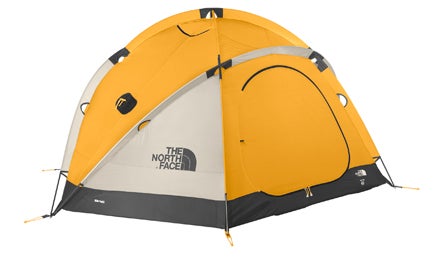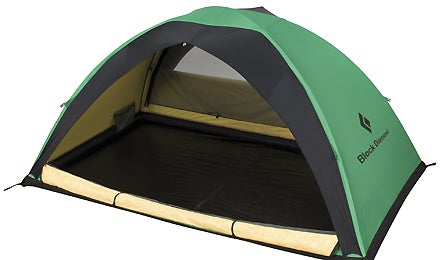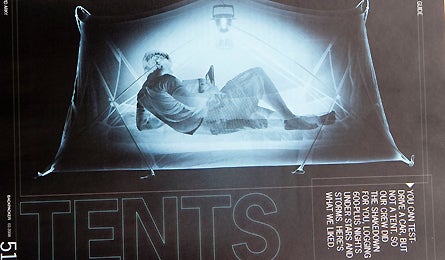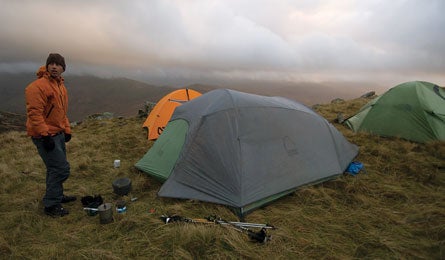Time-Tested Gear: Tents
A-frames, domes, party tents–we've tested them all.
Tried and True
The North Face VE-25
Veteran Pick
Black Diamond Bibler Ahwahnee
From the Vault
X-ray Power
Editors’ Choice Hall of Fame
Sierra Designs Lightning XT 4
Field Notes
Expert Wisdom
Best of BACKPACKER
See all Time-Tested Gear
The North Face VE-25 | Black Diamond Bibler Ahwahnee | X-ray Power |
Editors’ Choice Hall of Fame | Field Notes | Expert Wisdom |
See all Time-Tested Gear

Tried and True
The North Face VE-25
Of all the categories of gear we test, tents have undergone some of the most dramatic changes over the last few decades. Poles have gotten lighter and tougher, fabrics have gotten more weatherproof and packable, and designs have been revolutionized by hubbed pole systems that increase strength and space for the weight. That’s why the VE-25 is so astounding: It’s virtually the same tent we tested in the 1970s (it was called the VE-24 back then), and it still stands out among competitors.
Back when most tents were hoop or A-frame affairs that tried testers’ patience when it came to setup or wild weather, this sturdy, freestanding geodesic dome was a revelation. After pitching the 2010 version on 12,000-foot ridgelines in Colorado’s Indian Peaks Wilderness, our current tester says it’s as bomber as ever. “It’s spacious for three, well-vented, and reasonably light considering the absolute protection it provides.” Our prediction? We’ll be writing about it again 20 years down the road. $569; 9 lbs. 12 oz.; thenorthface.com.
The North Face VE-25 | Black Diamond Bibler Ahwahnee | X-ray Power |
Editors’ Choice Hall of Fame | Field Notes | Expert Wisdom |
See all Time-Tested Gear
Black Diamond Bibler Ahwahnee (Courtesy Photo)

Veteran Pick
Black Diamond Bibler Ahwahnee
“For me, being outside is all about the view, and this tent—with its gigantic, body-length twin doors—lets me see the landscape even when I have to be inside. What’s more, its mountaineering heritage makes it tough enough for any conditions, and light enough to take anywhere. The 33-square-foot interior squeezes in three when necessary, and an optional vestibule adds a huge front porch. $650; 5 lbs. 10 oz.; blackdiamondequipment.com. —Contributing Editor John Harlin III (and tester since 1987)
The North Face VE-25 | Black Diamond Bibler Ahwahnee | X-ray Power |
Editors’ Choice Hall of Fame | Field Notes | Expert Wisdom |
See all Time-Tested Gear

From the Vault
Voyeurism with an upside: For our March 2008 Gear Guide, photographer David Arky used X-ray technology to show an entirely new perspectve on equipment, allowing readers to gauge the interior space of this tent.
The North Face VE-25 | Black Diamond Bibler Ahwahnee | X-ray Power |
Editors’ Choice Hall of Fame | Field Notes | Expert Wisdom |
See all Time-Tested Gear
(Photo by Steve Howe)

Editors’ Choice Hall of Fame
Rarely, a piece of gear totally surpasses even our wildest expectations, as the Sierra Designs Lightning XT 4 did on a 2008 staff trip to Wales. We pitched this four-person ultralight atop an exposed plateau in torrential rain and 40-mph winds, and proceeded to jam seven shivering bodies inside for drinking and card games. It was a trip-saver. $450; 6 lbs. 13 oz.; sierradesigns.com.
The North Face VE-25 | Black Diamond Bibler Ahwahnee | X-ray Power |
Editors’ Choice Hall of Fame | Field Notes | Expert Wisdom |
See all Time-Tested Gear
Field Notes
“Always stake down even a freestanding tent! In the early 1990s, some BACKPACKER testers were drying a (pricy!) mountain tent on a Peruvian glacier, when a capricious gust cartwheeled it away and over a 1,500-foot cliff. Adios! Days later, they came across some campesinos with the tent strapped onto a burro, and they didn’t have the heart to ask for it back.”
—Dave Getchell, Gear Editor, 1988-1994
The North Face VE-25 | Black Diamond Bibler Ahwahnee | X-ray Power |
Editors’ Choice Hall of Fame | Field Notes | Expert Wisdom |
See all Time-Tested Gear
Expert Wisdom
1. Stop condensation. Create a low vent to let cool air in (the bottom of a door) and a high one (a ceiling vent or the top edge of an opposing door) to let warm air out.
2. Learn the tautline hitch. It’s the best knot for guying a tent as tight as a drum. backpacker.com/tautline.
3. Store it right. It’s fine to pack a wet tent on the trail, but dry it thoroughly before storing to prevent mold and mildew buildup.
